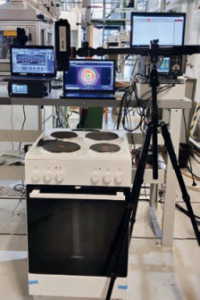
Liesipalo, cooktop fire, hob fire – is a common type of residential fires. This project aims at finding the reasons for their ignition, studying the consequences on indoor environment safety, and assessing ways of preventing or mitigating them.
The project is funded by Palosuojelurahasto.
Publications
- Simo Hostikka, Emmanuelle Castagnoli, Raimo Mikkola, Heidi Salonen, Tarique Jhatial, Rauli Törrö, Rahul Kallada Janardhan, Marjaleena Aatamila, Juha Laitinen, Marko Hassinen, Pekka Toivanen, Kalle Kiviranta, Laura Kuurne, Tarja Ojala, Jukka Lepistö. Liesipalojen syttyminen, vaikutukset ja ehkäisy. Aalto-yliopiston julkaisusarja TIEDE + TEKNOLOGIA 2/2024.
- Hostikka, S., Jhatial, T., Aatamila, M. Exploring the thermal characteristics, ignitions and heat release of oils and solid items at electric cooktops. Fire Safety J 140 (2023) 103889. https://doi.org/10.1016/j.firesaf.2023.103889
- Laura Kuurne, Tarja Ojala, Marjaleena Aatamila, Electric cooktop fire incidents in Finland, Fire Safety Journal 150,Part B (2024) 104283. https://doi.org/10.1016/j.firesaf.2024.104283
Theses
Jhatial, T. Thermal characterization of electric stoves. Aalto University. MSc Thesis. 2021. https://aaltodoc.aalto.fi/handle/123456789/110494
Conference presentations
- Jhatial, T., Hostikka, S. Thermal characterization of electric cooktops. Palotutkimuksen päivät 2021. Pelastustieto, Palotutkimuksen päivien erikoisnumero, s. 113-117. Palo- ja pelastustieto. https://www.spek.fi/wp-content/uploads/2021/08/PTP_2021.pdf.
- Ojala, T. (2021). Turvatekniikka ja liesipalojen ehkäisy. Teoksessa: Puustinen, Alisa 2021 (toim.). Pelastus- ja turvallisuustutkimuksen vuosikirja 2021, s. 8–27. Pelastusopiston julkaisu, D-sarja: Muut julkaisut 1/2021. Pelastusopisto, Kuopio. http://info.smedu.fi/kirjasto/Sarja_D/D1_2021.pdf.
- Lepistö, J. & Kuurne, L. & Ojala, T. (2021). Liesipalojen kokonaiskuva ja liesiturvallisuutta vaarantavat tekijät. Palotutkimuksen päivät 2021. Pelastustieto, Palotutkimuksen päivien erikoisnumero, s. 8-12. Palo- ja pelastustieto. https://www.spek.fi/wp-content/uploads/2021/08/PTP_2021.pdf.
- Castagnoli, E., Mikkola, R., Törrö, R., Kallada Janardhan, R., Hostikka, S., Salonen, H. Chemical exposure from overheated food in a test kitchen. Indoor Air 2022, June 12-16, 2022, Kuopio.
- Hostikka, S. Liesipalot. Ekotehokkaan rakentamisen ja talotekniikan yhteistyötapaaminen. 27.1.2022.
- Hostikka, S., Castagnoli, E., Kallada Janardhan, R., Törrö, R., Jhatial, T., Mikkola, R., Salonen, H. Production of heat and harmful products from cooktop fires and overheated materials. Nordic Fire and Safety Days 2022, June 21-22, 2022. Lund.
- Kuurne, L., Lepistö, J., Ojala, T. The overall picture of stove fire incidents in Finland and factors endangering stove safety. Nordic Fire and Safety Days 2022, June 21-22, 2022. Lund.
- Hostikka, S. Liesipalojen syttyminen, vaikutukset ja ehkäisy. Paloseminaari 2023. Rakennusteollisuus. Helsinki. 7.2.2023
- Laitinen J., Aatamila, M. Tutkimustietoa palojen aiheuttamista kemiallisista altistumisista. Pelastuslaitosten ilmoitusmenettelyt ja viranomaisyhteistyö palojen tutkinnassa -hankkeen webinaari 20.4.2023 (tulossa)
- Aatamila, M., Hassinen, M., Toivanen, P., Kiviranta, K., Laitinen J. Asumisterveys huoneistossa, kemialliset altisteet ja niiden vähentäminen liesipalotilanteen jälkeen. Palotutkimuksen päivät 2023.
- Hostikka, S., Jhatial, T., Aatamila, M., Toivanen, P., Kiviranta, K., Hassinen, M. Liesipalojen syttyminen ja paloteho – laboratoriokokeet. Palotutkimuksen päivät 2023.
- Hostikka, S., Castagnoli, E., Mikkola, R., Törrö, R., Kallada Janardhan, R., Salonen, H., Haitallisten aineiden syntyminen ja tuuletus liesipaloissa – laboratoriokokeet. Palotutkimuksen päivät 2023.
- Hostikka, S. Fire ignition on electric cooktops. Aalto Family Day, 10.9.2022.
Research results
WP 2: Thermal characterization
Thermal characterization of three types of electric stoves were performed using thermocouples, IR camera, and Hukseflux SBG01 heat flux gauge.
These results are, of course, specific to the particular cooktop models, but some general observations can be made:
- Glass ceramic and induction cooktops are faster than electric coil.
- Induction cooktop had a safety feature that limited the peak temperatures of cast iron and carbon steel pans lower than at other cooktops.
- Aluminum pan peak temperatures were lower than cast iron and carbon steel pans at all cooktops.
WP2: Ignition tests
Ignition tests were carried out for different food and kitchen materials.
In addition, the heat release rates were measured using the oxygen consumption calorimetry.

Measurement of sunflower oil heat release rate on aluminum pan and ceramic glass cooktop. Photo: Simo Hostikka
IR video 1 : 23 g of sunflower oil vaporizes from a pan, creating a foaming char.
IR video 2: 10 x 10 cm2 version of a pizza box heated and ignites (Warning: temperature scale not calibrated)
IR video 3: 23 g canola oil in cast iron pan, ignites to flaming.
WP 3: Indoor health
Third series of tests examines the effect of small kitchen fires and burned food on the indoor air quality. For this study, we built a 2 x 2 x 2.5 m3 room with mechanical ventilation.
VIDEO: Paper towel roll (15 min min test, 50 x speed-up)
Two pieces of sausage in a pan:







